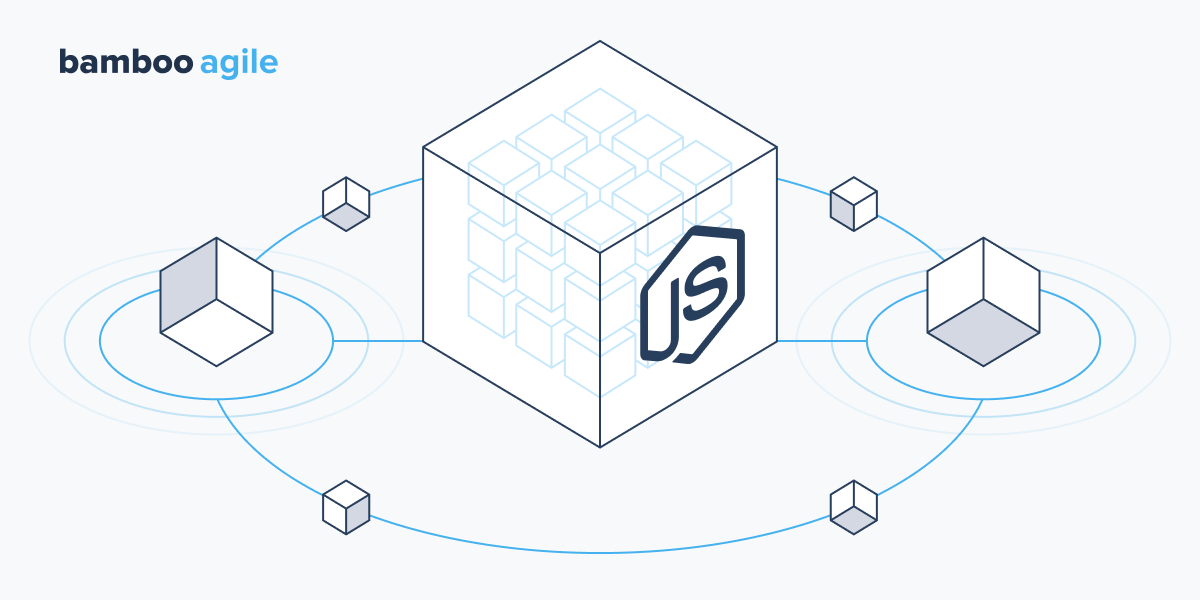Introduction
Many people think that microservices are very difficult. But in fact, given the right approach, this is not the case at all.
Microservices are very popular today, and the true adherents of this architecture almost bow to everything that says “microservice”. However, fanaticism aside, this method of software development is a worthy step forward for the industry, and microservices can forever change how application backends are built. There is a lot of information noise around microservices, so it is worth highlighting the really important features of this architecture and working on making it easier to implement and use it where it is really needed.
What is a Microservice
The microservices architectural style is an approach in which the system is built as a set of independent and loosely coupled services that can be created using various programming languages and data storage technologies. These functional modules are independently deployed, scaled, targeted to specific business goals, and communicate with each other over standard protocols such as HTTP, APIs, and lightweight asynchronous messaging.
The main advantage of the microservices architecture is that modules can be implemented using different programming languages, have their own databases, and be deployed in different software environments such as on-premises or in the cloud.
Pros and Cons of the Microservices Architecture
As with any other decision, to make it, you have to consider all the pros and cons. Let’s take a closer look at the advantages and disadvantages of microservices to see if this technology is the best choice for you.
Pros
- Scalability. It’s more effective to support a complex application in a large team if the application is based on microservices, since it is easier to distribute responsibilities between developers.
- Flexible development. Creating applications based on microservices allows developers to focus on well-defined modules, which makes development, testing and maintenance more flexible and optimised.
- More efficient deployment. Unlike with a monolithic architecture, whenever a microservice needs to be updated, there is no need to deploy the entire application. The only requirement is to release a REST-ful API for other services.
- Easier iterations. Developers can iterate over microservices separately, they are not restricted by other components.
- Language agnostic. Microservices can be written in different programming languages, which provides significant flexibility in the development of the entire application.
Cons
- Managing the entire block is difficult. Microservices architecture can be a double-edged sword. On the one hand, it is easier to maintain multiple small units than a single large and complex one. On the other hand, whenever there is a need to manage the application as a whole, microservices make it more difficult.
- Difficult trials. Testing has the same problem — it may seem more efficient to test each microservice separately, but finding errors is generally faster in monolithic applications, which also allow you to run end-to-end testing.
- More common problems. Logging in, caching, and other issues affecting the entire application are easier to solve in a monolithic architecture, because only one application needs to be taken care of.
- Multiple deployments. When working with monolithic applications, developers need to handle only one deployment. But microservices may require multiple deployments. In some cases, having fewer deployments to deal with saves a lot of time and effort for developers.
Our blog has an article about migration from monoliths to microservices. Feel free to read it!
Why Use Microservices with Node.js

Node.js is well suited for microservices. It is very fast at runtime, single-threaded, event-driven, highly scalable, and comes with asynchronous libraries, as well as smaller buffers.
Some of the obvious advantages of using modern approaches and software development technologies, such as microservice and Node.js, are listed below:
Simple Development
Large-scale systems are difficult to understand, build, and maintain because they are complex. With Node.js microservices, those systems become extremely easy to update, deploy and manage, since they are split into smaller independent components.
Developers should not interfere with each other’s tasks when workflow development is simplified. They are just working on the relevant parts of the application being developed.
Cost-Effective and Fast Entry
Node.js is great for microservices architecture, allowing developers to create small components that easily fit into a continuous delivery pipeline to speed up time to market.
Node.js microservices allow you to scale only the parts you need, saving you time, effort and, as a result, money.
Built-In Web Server
You don’t need to deal with another Nginx or Apache instance: the web server is included in JavaScript. With Node.js, you can also say goodbye to things like FPM, because JavaScript is a single-threaded language.
Easy Updates and Maintenance
Node.js uses a modular approach to application development, allowing developers to use the microservices architecture for faster and simpler step-by-step updates. In addition, since the Node.js microservices system is loosely connected and independent, developers will have no problems with its maintenance.
The process is simplified by the absence of complex monolithic code. This way, developers can easily add new features to the app. Even when making updates, they can gradually improve the system, instead of investing heavily in large-scale rewriting. This approach is facilitated by the functionality of Node.js, since it allows for a service-oriented and modular structure.
Easy to Use, Install, Integrate, and Maintain
Compared to Java programming, .NET, and Python, NodeJS code is easier to set up and maintain. It doesn’t require any complicated configuration settings. Node.js allows you to quickly develop and configure APIs using such frameworks as Express, Sail, and Hapi.
API calls and message intermediaries are the most common ways microservices interact. Most modern message brokers integrate with Node.js easily and quickly, and as a whole, Node.js is best suited for distributed systems.
Business Focus
Microservices architecture improves collaboration and mutual understanding between teams, as it is broken down into smaller components by business areas. Adding new features to microservices is also much easier for developers than adding new features to old monolithic development models.
Improved Performance
Node.js has a package manager with several modules that developers can instantly use. This saves them a lot of effort in the application development process. Also, applications in Node.js are written in JavaScript. This allows interface developers to easily understand what is going on and lets them make the necessary changes to the applications.
One language can be used across the entire stack. In addition, developers can use the same modules both in the backend and in the external interface. This helps them save an incredible amount of time while increasing the productivity of the process.
Data Replication
Data replication is important for microservices that interact well with Node.js. In addition, developers can take advantage of NoSQL databases.
In fact, this is an alternative approach to the traditional tabular database model. Using Node.js, developers can optimise the benefits of this feature. It is often available for free on the market.
Thus, the low learning curve of JavaScript, the flexibility and, scalability of Node.js, as well as its API support and ease of microservices development in microservices will benefit organisations and allow developers to create business-oriented applications that meet business goals.
Microservices: Best Practiсes
From learning the microservices architecture for your next project to completing the deployment of the application — here we’ve grouped the best practices into categories reflecting the growth stages of the software development lifecycle (SDLC).
For Planning and Organisation
Evaluate whether the microservice architecture is suitable for your needs: switching to a microservice architecture just because big names are using it is not a good decision. You should examine your needs to determine where you could break them down into useful functions.
Support everyone with your idea: the transition from monolithic architecture to microservices is a long and painstaking process that affects not only the development team. Form teams based on microservices, where each microservice is treated as a separate application.
When Designing a Microservice
Make distinctions between your microservices and your business functions and services. If you do this, you can avoid creating microservices that are too big or too small.
Create loosely coupled services with extensive connectivity that span a single limited environment. This ensures that the microservice will be used in only one context, resulting in domain-driven design (DDD).
When setting up communication between services, use API and events instead of having the services call each other directly. Create an API gateway that manages authentication, service requests and responses, and throttling. If you have an API gateway, you can quickly redirect traffic to the updated version of your service.
And of course, always consider potential security flaws in the design of microservices.
When It Comes to Creating a Microservices Architecture
Each service should have its own version control strategy. In order to easily prepare and clean version control logs, each service must have its own repository.
The development environment should be the same on all machines. Set up your service’s development environment as virtual machines so that your software engineers can quickly set up the structure and get to work.
Backward compatibility must be enabled for the service endpoints you provide. Backward compatibility is also possible with API calls made in response to each user request. This will allow your company to develop production-ready applications faster.
For Data Storage and Administration
Each microservice should have its own database or data warehouse. Choose a database that meets the requirements of your microservice, adapt the architecture and storage to the data it will contain, and don’t use it for anything else.
For Deployment and Hosting
Deploy your microservices separately: this saves time when working with multiple teams during scheduled maintenance or upgrade projects.
Containerize your microservices. Microservices and containers often go hand in hand. Individual services can be deployed and managed separately using container microservices.
Make your microservices a separate assembly and automate the deployment process.
For Operation and Maintenance
Use a centralised registration and monitoring system. A centralised logging system ensures that all microservices send logs in the same format, storing logs separately for each service.
In our blog we also have an article on Node.js for e-Commerce with expert insights from our team!
Conclusion
The microservices architecture and Node.js are so closely related that it seems like they were created for each other. Both have the same main goal (same approach, different execution time): develop scalable applications faster to save time and money. Using Node.js you can develop microservices in various ways.
But while microservices are great, building a scalable microservices application on any platform requires a lot of work. You have to think about things like cluster management, organisation of services, communication between services, and so on.
So, if you think your business idea will work well using microservices, or maybe you want to rebuild an existing application to make it more modern, contact Bamboo Agile. Our specialists are going to be right there to help you!



